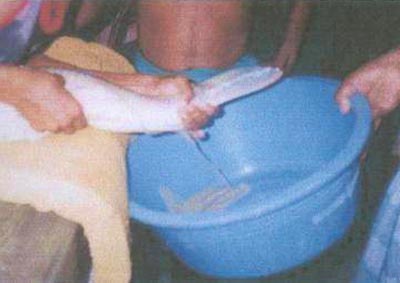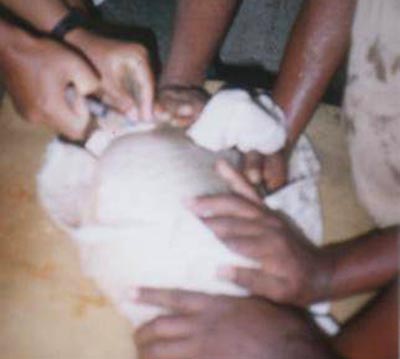
Hatchery is one of the main sources of fry for fish culture and about 98% fry of the country is produced by the hatcheries (Amin, 2002). It seems that the establishment of new hatcheries is playing an active role in the fish production of Bangladesh. Hatchery management is a very important part of aquaculture in Bangladesh. Brood stock and breeding management are the main parts of fin fish hatchery management which are mentioned in bellow.
Brood stock management:
A hatchery must have healthy and fresh brood fish to produce healthy fry. So, they have the provision of stocking of brood fishes in own care. The surveyed hatchery owner rears the broods in their own ponds. Some times they sell the brood from market. It is recorded that the hatchery owners are careful to rear the broods comparatively. Both organic and inorganic fertilizers are used for increasing the natural feed. Such as cow dung, poultry waste, urea and TSP etc. Wang and Zhang (1984) recommended a method of using phosphorous fertilizer in manure-loaded ponds. To get better seed production supplementary feed like oilcake, rice bran, molasses, wheat bran, wheat flour, fish meal, blood of cow and goat and vitamin are supplied at the rate of 2-3% of total body weight in every day in the morning and evening. Similar observation was reported by Gupta et al. (1976). Daily fed with supplementary feeding of 35-40% protein range is suitable for better result.
Breeding management:
Brood identification and selection are very important for breeding management. Mature male and female brood fishes are selected by their external characteristics (Chaudhury, 1959). Success of induced spawning depends on proper selection of broods. Healthy, disease free and uninjured broods are selected for the induced spawning. Normally polythene bag, plastic bag, aluminum pot etc. are used for brood transportation.

Resting or conditioning period before 1st injection is found 5.5-24 hours for native and 5.5-24 hours for exotic species. First doses of PG (ml/kg body weight) are applied only female of native carps 1.90 to 2.38 ml/kg body weight and for exotic species the first doses are applied only female 2.00 to 3.17 ml/kg body weight and also for silver carp and bighead carp first doses are applied only female 265.00 HCG (IU/kg body weight). Second doses are applied both male and female ranges from 6.32 to 7.00 PG (ml/kg body weight) for native species and for exotic species it was 6.00 to 7.58 PG (ml/kg body weight). In case of some exotic fishes, only single doses are used both male and female. Species wise doses of PG injection and duration of spawning and production of fry are presented in the following table1 and table2.
Table 1: Amount of PG dose, average duration of different dose and spawning and production of fry
|
Species |
Amount of 1st dose (ml/kg body weight) |
Amount of 2nd dose (ml/kg body weight) |
Duration (h) between 1st and 2nd dose |
Duration (h) between 2nd dose and spawning |
Production (kg/ hatchery/yr) |
| Native carp | |||||
|
Rui |
1.94 |
6.81 |
6.33 |
6.00 |
185.42 |
|
Catla |
2.04 |
6.60 |
6.33 |
5.98 |
46.74 |
|
Mrigel |
1.97 |
6.56 |
6.50 |
5.94 |
135.63 |
|
Bata |
2.00 |
6.32 |
6.89 |
5.86 |
135.44 |
|
Calbaush |
1.90 |
6.60 |
6.35 |
6.00 |
42.69 |
|
Raikhor |
2.38 |
7.00 |
6.40 |
5.78 |
30.00 |
|
Exotic species |
|
|
|
|
|
|
Grass carp |
1.86 |
6.50 |
7.88 |
6.00 |
52.95 |
|
Common carp |
1.93 |
6.54 |
6.67 |
6.00 |
47.55 |
|
Thaiputi |
2.20 |
6.48 |
6.77 |
5.80 |
49.50 |
|
African Magur |
2.80 |
6.20 |
6.00 |
6.00 |
55.00 |
|
Thai pangus |
2.00 |
6.00 |
6.00 |
6.00 |
55.00 |
Table 2: Amount of HCG and PG dose, average duration of dose and spawning and production of fry
|
Species |
Amount of 1st dose (HCG) (ml/kg body weight) |
Amount of 2nd dose (PG) (ml/kg body weight) |
Duration (h) between 1st and 2nd dose |
Duration (h) between 2nd dose and spawning |
Production (kg/ hatchery/yr) |
| Native carp | |||||
|
Silver carp |
265.00 |
7.58 |
9.54 |
6.04 |
170.96 |
|
Bighead carp |
265.00 |
7.58 |
9.50 |
6.00 |
113.23 |
References:
- Amin, M. R. 2002. Fisheries resource development Vs uncontrolled hatchery industry. MPS, 2002. p36.
- Chaudhuri, H. 1959. Notes on external characters distinguishing sex of breeders of the common Indian carps. Sci. Cult. 25(10): 258-259.
- Gupta, S. D., H. A. Khan and R. M. Bhowmick, 1976. Preliminary observations on the effect of vitamins and growth hormone. On the gonadal maturity of Carps. In: Symposium on Inland Aquaculture (Abstract) February, 1976. Central Inland Fisheries Research Institute, Barrakpur. 30: 12-14.
- Wang, B. & Zhang, X. P. 1984. Aprimary study on the ecological factors of ponds, fertilized with inorganic fertilizers. Freshwater Fisheries. 2:16-20
Visited 4,324 times, 1 visits today | Have any fisheries relevant question?
